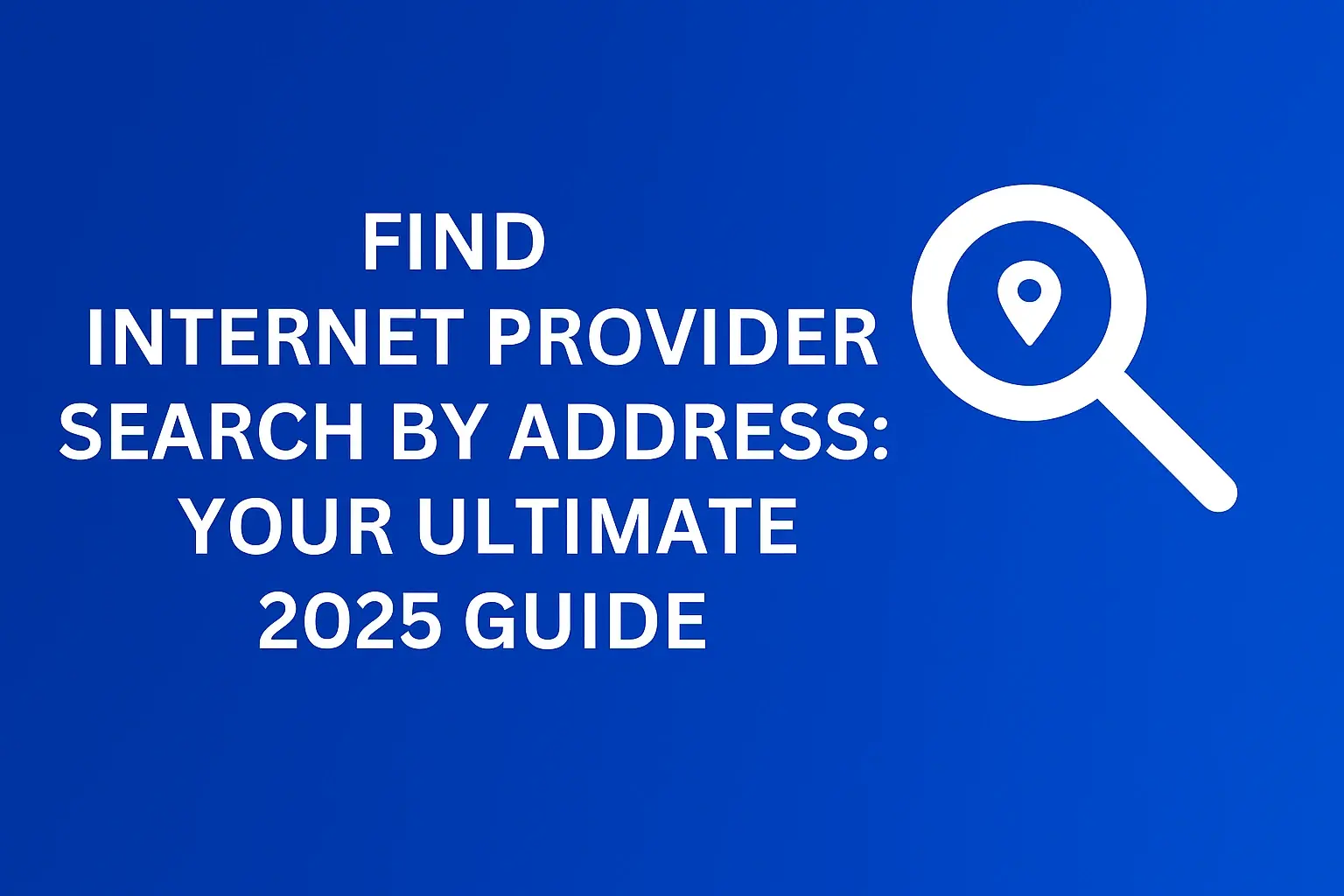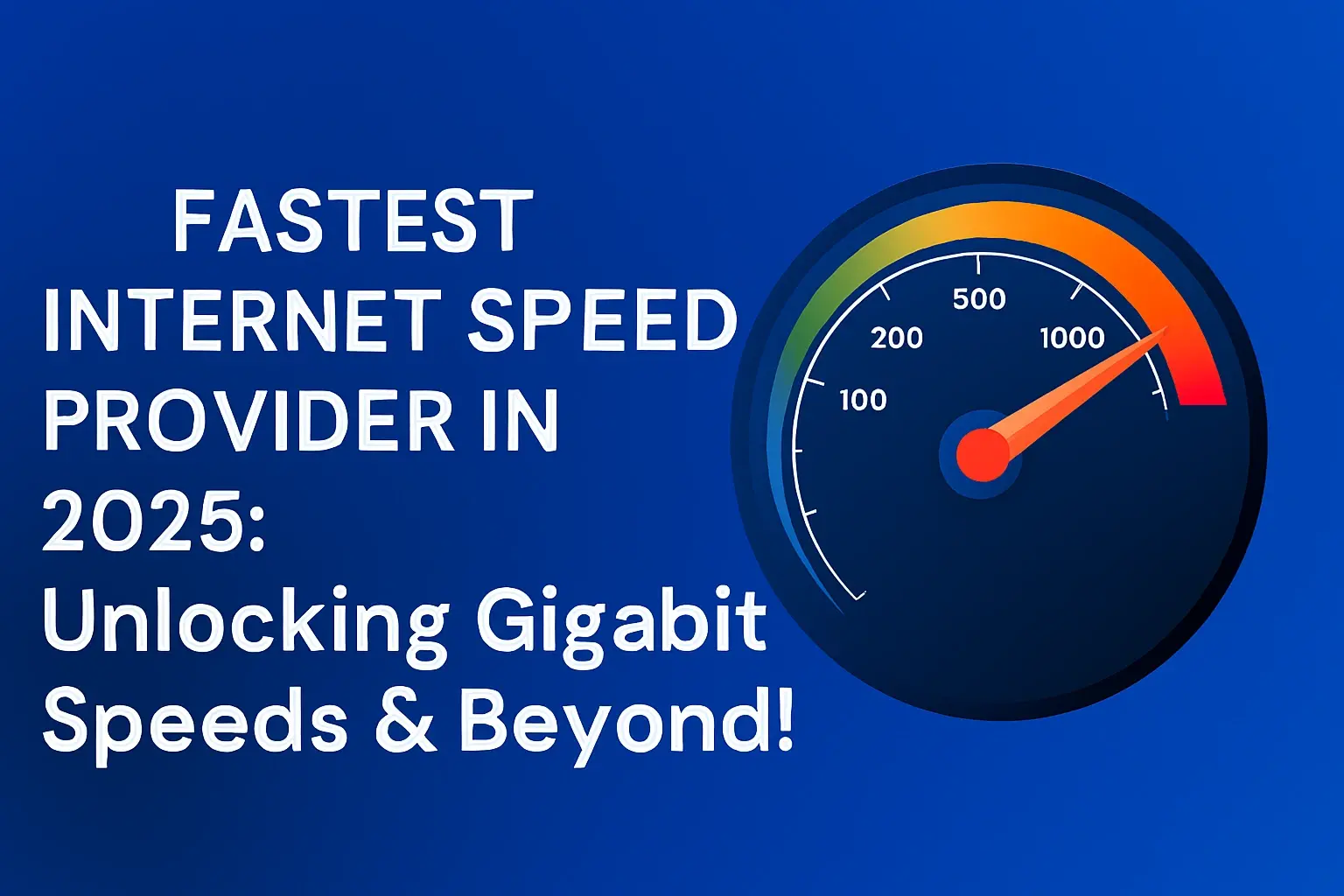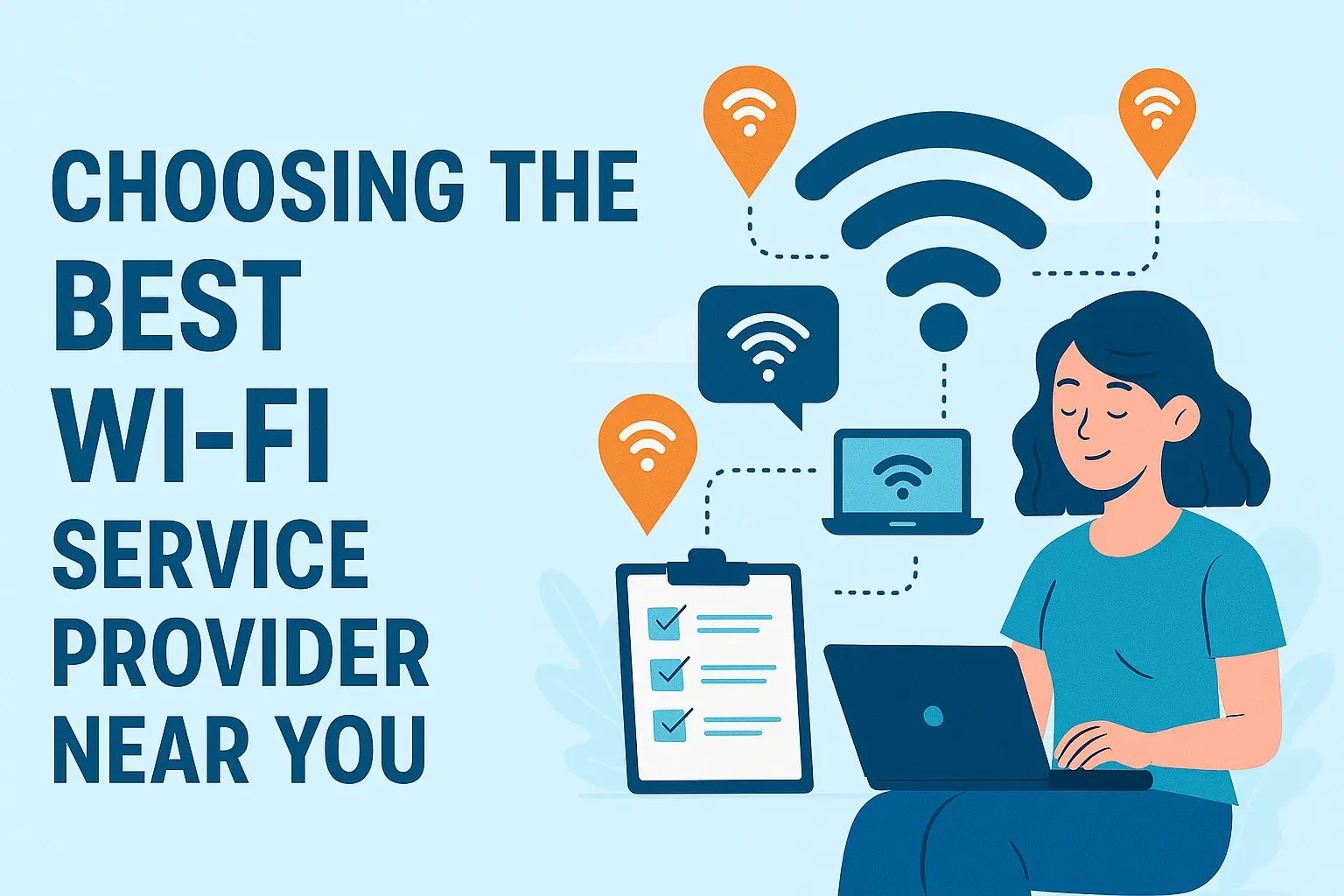Why It’s Time to Change Your Internet Provider for Business

Is your business internet holding you back? Slow speeds, unreliable connections, and poor support can cripple productivity and hinder growth. This guide explores the compelling reasons why it's time to reassess your current provider and upgrade to a solution that truly supports your business objectives in 2025.
Introduction: The Hidden Costs of Subpar Business Internet
In today's hyper-connected business landscape, a robust and reliable internet connection is no longer a luxury; it's the backbone of operations. For many businesses, the existing internet service provider (ISP) has become a silent drain on resources, impacting everything from daily productivity to long-term growth potential. This article delves into the critical indicators that signal it's time to upgrade your business internet, exploring the drawbacks of outdated infrastructure and the transformative benefits of switching to a modern, high-performance solution.
Signs It's Time to Change Your Internet Provider
Recognizing the symptoms of an underperforming internet service is the first step toward finding a better solution. Ignoring these signs can lead to significant financial losses, damaged reputation, and missed opportunities. Here are the most common indicators that your business has outgrown its current internet provider.
Persistent Performance Issues
Slow loading times, dropped video calls, and lagging applications are more than just annoyances; they are direct impediments to productivity. If your team frequently experiences delays when accessing cloud-based tools, uploading large files, or conducting video conferences, your current internet speed and stability are likely insufficient. In 2025, with the increasing reliance on real-time data processing and cloud applications, even minor performance hiccups can translate into lost work hours and decreased output. For instance, a marketing team struggling to upload high-resolution graphics for a campaign, or a sales team unable to join a critical client demo due to lag, are experiencing direct financial impacts. According to a 2025 study by TechAnalytics, businesses with consistently slow internet report an average of 15% lower employee productivity compared to those with high-speed connections.
Reliability Concerns and Downtime
Frequent internet outages, even short ones, can be devastating for businesses. Every minute of downtime means lost sales, interrupted customer service, and potential data loss. If your current provider has a history of unreliability, or if you find yourself constantly troubleshooting connection issues, it's a clear sign that their infrastructure is not robust enough to support your business's critical operations. Consider the impact of a single hour of downtime on a retail business during peak season, or on a financial firm processing transactions. The cost can easily run into thousands or even tens of thousands of dollars. A 2025 report from the Global Business Continuity Institute found that the average cost of unplanned IT downtime for small to medium-sized businesses (SMBs) is approximately $5,600 per hour.
Inadequate Bandwidth for Modern Needs
The demands on business internet bandwidth have exploded. Cloud computing, VoIP services, video conferencing, remote work, and the Internet of Things (IoT) all consume significant bandwidth. If your current plan was sufficient a few years ago, it's likely inadequate now. Businesses in 2025 often require symmetrical upload and download speeds to effectively manage cloud-based workflows and host virtual meetings. A plan with disproportionately low upload speeds, for example, will severely hamper the ability to share large files or stream high-quality video. Many older business plans are asymmetrical, prioritizing download speeds which are less critical for modern cloud-centric operations. A common scenario is a design agency unable to share large project files with clients efficiently, leading to project delays and client dissatisfaction.
Poor Customer Support and Slow Resolution
When issues arise, prompt and effective customer support is crucial. If your current provider is difficult to reach, provides unhelpful technical assistance, or takes days to resolve problems, it's a significant liability. Businesses need a partner who understands their needs and can quickly diagnose and fix issues. Waiting for a technician or enduring long hold times can directly impact your ability to operate. For example, a restaurant relying on online ordering and payment systems cannot afford extended downtime due to internet issues, and their ISP's support response time directly affects their revenue. A survey of IT managers in 2025 indicated that 70% of businesses consider responsive and knowledgeable customer support a primary factor when choosing an ISP.
Escalating Costs Without Corresponding Value
While it's expected that costs may rise over time, they should be accompanied by commensurate improvements in service, speed, or features. If you're paying more for the same or even degraded service, it's a clear sign that you're not getting value for your money. Many older contracts auto-renew with price increases, and businesses may not be aware of more cost-effective, higher-performance options available in the market. It's essential to periodically review your billing and compare it against current market offerings. A business that has been with the same provider for five years might be paying 30-40% more than a comparable new customer for a slower service.
Lack of Scalability and Future-Proofing
Your business is dynamic; it grows, adapts, and evolves. Your internet service needs to keep pace. If your current provider offers limited options for upgrading speeds, adding new locations, or integrating advanced services like SD-WAN, they are hindering your future growth. A provider that can't easily scale with your business can become a bottleneck. Imagine a startup that experiences rapid growth; if their internet plan can't be quickly upgraded to handle increased user load and data traffic, their expansion will be stifled. In 2025, providers offering flexible, scalable solutions are crucial for businesses aiming for sustained growth.
Security Vulnerabilities and Outdated Infrastructure
Cybersecurity is paramount for all businesses. An outdated internet infrastructure may lack the built-in security features and protocols necessary to protect against modern threats. Some older technologies are inherently more vulnerable to attacks, and providers who haven't invested in upgrading their network may offer less robust security measures. This can expose your business to data breaches, ransomware, and other cybercrimes. For businesses handling sensitive customer data or intellectual property, this is an unacceptable risk. Modern business internet solutions often include advanced security features, such as managed firewalls and intrusion detection systems, as part of their service packages.
The Tangible Benefits of Switching Your Business Internet Provider
Moving to a new internet provider isn't just about fixing problems; it's about unlocking new potential. The right internet service can be a powerful catalyst for business improvement across multiple facets of your operations.
Boosted Productivity and Efficiency
Faster, more reliable internet directly translates to increased productivity. Employees spend less time waiting for pages to load, files to download, or applications to respond. This allows them to focus on their core tasks, leading to more work being completed in less time. For example, a software development team can deploy code updates more rapidly, and customer service agents can access customer information and resolve queries faster. A 2025 survey by Business Productivity Insights found that companies upgrading to gigabit fiber speeds reported an average productivity increase of 20-25%.
Enhanced Collaboration and Communication
Modern collaboration tools, from video conferencing platforms like Zoom and Microsoft Teams to cloud-based project management software, rely heavily on stable, high-speed internet. A robust connection ensures seamless virtual meetings, real-time document co-editing, and efficient communication across teams, regardless of their physical location. This is particularly crucial for businesses with remote or hybrid workforces. Imagine a global team collaborating on a complex design project; uninterrupted video feeds and instant file sharing are essential for their success. Providers offering dedicated bandwidth for critical applications ensure these tools perform optimally.
Improved Customer Experience
Your internet service directly impacts how your customers interact with your business. Slow website loading times can lead to high bounce rates. Unreliable online ordering systems can result in lost sales and frustration. Poor quality video calls with clients can damage your professional image. By upgrading your internet, you ensure a smooth, efficient, and positive experience for your customers, whether they are browsing your website, making a purchase, or engaging with your support team.
Greater Scalability and Flexibility
As your business grows or experiences seasonal peaks, your internet needs will change. A modern provider will offer flexible plans and the ability to quickly scale bandwidth up or down as required. This agility allows you to adapt to changing business demands without being constrained by your network infrastructure. For example, a retail business can temporarily increase bandwidth during the holiday shopping season and then scale back down, optimizing costs and performance.
Strengthened Security Posture
Reputable business internet providers in 2025 offer advanced security features as part of their service. This can include managed firewalls, intrusion detection and prevention systems, VPN capabilities, and regular security updates. By partnering with a provider that prioritizes security, you can significantly reduce your vulnerability to cyber threats and protect your sensitive business data.
Potential Cost Savings and Better ROI
While the initial investment in a premium internet service might seem higher, the long-term benefits often lead to significant cost savings and a better return on investment (ROI). Increased productivity, reduced downtime, improved customer retention, and enhanced operational efficiency all contribute to a healthier bottom line. Furthermore, competitive pricing and bundled services from newer providers can sometimes offer better value than outdated, overpriced plans from legacy providers.
Understanding Your Business Internet Options in 2025
The landscape of business internet connectivity has evolved dramatically. Understanding the different technologies available will help you make an informed decision. Here's a look at the most prevalent and effective options for businesses in 2025.
Fiber Optic Internet
Description: Fiber optic internet uses thin strands of glass to transmit data as pulses of light. It is the fastest and most reliable internet technology available today.
Key Features for Business:
- Symmetrical Speeds: Offers identical, high-speed upload and download capabilities, crucial for cloud services, video conferencing, and large file transfers. Speeds can range from 100 Mbps to 10 Gbps and beyond.
- Exceptional Reliability: Less susceptible to environmental interference (weather, electromagnetic signals) than copper-based technologies.
- Low Latency: Minimal delay in data transmission, vital for real-time applications and gaming.
- Scalability: Easily upgradeable to higher speeds as network technology advances.
Best For: Businesses of all sizes that rely heavily on cloud applications, video conferencing, large data transfers, and require maximum uptime and performance.
Ethernet Services
Description: Ethernet services, often referred to as Dedicated Internet Access (DIA) over Ethernet, provide a direct, dedicated connection from your business to the provider's network. It's a highly scalable and reliable solution.
Key Features for Business:
- Guaranteed Bandwidth: You get the full bandwidth you pay for, with no sharing among other users.
- Symmetrical Speeds: Typically offers symmetrical upload and download speeds, often starting at 100 Mbps and scaling up to 10 Gbps or more.
- High Availability: Often comes with strong Service Level Agreements (SLAs) guaranteeing uptime.
- Quality of Service (QoS): Allows prioritization of certain types of traffic (e.g., VoIP, video conferencing) for optimal performance.
Best For: Medium to large enterprises, businesses with critical uptime requirements, and organizations needing predictable performance for mission-critical applications.
Fixed Wireless Internet
Description: Fixed wireless uses radio waves to connect a business location to a provider's network via antennas. It's often used in areas where fiber is not yet available.
Key Features for Business:
- Faster Deployment: Can be deployed more quickly than wired connections in some locations.
- Good Speeds: Can offer competitive speeds, though often not as high or as consistently reliable as fiber.
- Cost-Effective: Can be a more affordable option in certain rural or underserved areas.
Considerations: Performance can be affected by weather, line-of-sight obstructions, and network congestion. Speeds are typically asymmetrical.
Best For: Businesses in areas lacking fiber infrastructure, or as a backup connection.
SD-WAN Integration
Description: Software-Defined Wide Area Networking (SD-WAN) is not an internet connection type itself but a technology that optimizes the use of multiple internet connections (including fiber, broadband, and even 4G/5G wireless). It intelligently routes traffic across the best available path.
Key Features for Business:
- Improved Performance: Dynamically directs application traffic over the most efficient link, enhancing speed and reducing latency.
- Enhanced Reliability: If one internet connection fails, SD-WAN automatically switches traffic to another available link, ensuring business continuity.
- Cost Optimization: Can leverage less expensive broadband connections for non-critical traffic while prioritizing critical applications over dedicated links.
- Centralized Management: Simplifies network management and deployment across multiple locations.
Best For: Businesses with multiple locations, complex network needs, a mix of critical and non-critical applications, and those seeking to maximize the performance and reliability of their internet infrastructure.
Dedicated Internet Access (DIA)
Description: DIA guarantees a specific amount of bandwidth that is exclusively for your business. It's often delivered over fiber or robust Ethernet connections.
Key Features for Business:
- Guaranteed Bandwidth: You always have access to the full speed you pay for.
- Symmetrical Speeds: Essential for businesses that upload as much data as they download.
- High Uptime Guarantees: Typically backed by strong SLAs, often 99.9% or higher.
- Prioritized Traffic: Network traffic is often prioritized, ensuring consistent performance.
Best For: Businesses with high bandwidth demands, mission-critical online operations, and those requiring the highest levels of reliability and performance.
How to Choose the Right Business Internet Provider
Selecting a new internet provider requires careful consideration. A strategic approach ensures you find a solution that aligns with your business goals and budget. Here’s a step-by-step guide to making the best choice.
Assess Your Business Needs
Before you even start looking at providers, understand what your business truly requires. Consider:
- Current Bandwidth Usage: Monitor your network traffic over a typical month. How much data do you download and upload? What are your peak usage times?
- Application Requirements: List all critical applications (VoIP, CRM, video conferencing, cloud storage, custom software). What are their bandwidth and latency requirements?
- Number of Users and Devices: How many employees will be using the internet simultaneously? How many devices (computers, phones, IoT sensors) will be connected?
- Future Growth Projections: How do you anticipate your business needs evolving over the next 1-3 years?
- Uptime Requirements: How much downtime can your business tolerate? What is the financial impact of an outage?
Example: A small law firm might need reliable internet for cloud-based case management software and video depositions, requiring decent upload speeds. A large e-commerce business will need massive download and upload capacity, extremely low latency, and guaranteed uptime to handle thousands of transactions per hour.
Research Providers and Plans
Once your needs are clear, begin researching providers available in your area. Look beyond the national brands; local and regional providers can sometimes offer superior service and support for businesses.
- Availability Check: Use online tools or contact providers directly to see what services are available at your business address.
- Technology Options: Determine which technologies (fiber, Ethernet, fixed wireless) are viable and best suit your needs.
- Plan Comparison: Compare advertised speeds (download/upload), data caps (though most business plans have none), and included features.
- Bundled Services: Some providers offer bundles that include VoIP, managed Wi-Fi, or cybersecurity services. Evaluate if these are beneficial.
Tip: Look for providers specializing in business services, as they often offer more robust solutions and better support than residential plans.
Understand Service Level Agreements (SLAs)
SLAs are critical for business internet. They are formal contracts that define the level of service you can expect from your provider, including:
- Uptime Guarantees: The percentage of time the service will be available (e.g., 99.9% uptime).
- Latency Guarantees: Maximum acceptable delay for data transmission.
- Jitter Guarantees: Maximum acceptable variation in latency, important for voice and video.
- Packet Loss Guarantees: Maximum acceptable percentage of data packets that fail to reach their destination.
- Response and Resolution Times: How quickly the provider will acknowledge and fix issues.
- Service Credits: What compensation you receive if the provider fails to meet SLA guarantees.
Example: A 99.9% uptime SLA means approximately 8.76 hours of downtime per year. A 99.99% uptime SLA allows for only about 52.6 minutes of downtime annually. For mission-critical operations, the latter is essential.
Evaluate Customer Support and Reputation
When issues arise, you need a provider with responsive and knowledgeable support. Research the provider's reputation for customer service:
- Online Reviews: Check review sites, forums, and business directories for customer feedback.
- Ask for References: Request to speak with other businesses in your industry or location that use the provider.
- Support Channels: What channels are available (phone, email, chat)? What are their operating hours? Is there a dedicated business support team?
- Technical Expertise: Do they have experienced technicians who can troubleshoot complex business network issues?
Tip: A provider with a strong track record of proactive support and quick problem resolution is invaluable.
Consider Scalability and Future Growth
Your business is not static. Choose a provider that can grow with you. Inquire about:
- Upgrade Paths: How easy and fast is it to increase your bandwidth or upgrade to a different service tier?
- Adding Services: Can they easily add new locations or services as your business expands?
- Technology Roadmaps: Does the provider invest in upgrading their infrastructure to offer future technologies?
Example: A startup that expects rapid growth should choose a provider that can seamlessly upgrade their connection from 100 Mbps to 1 Gbps or higher within days, not weeks or months.
Compare Pricing and Contracts
While price is a factor, it shouldn't be the only one. Understand the total cost of ownership:
- Monthly Fees: Compare the recurring costs for similar plans.
- Installation Fees: Are there one-time setup costs? Can these be negotiated?
- Equipment Costs: Are modems, routers, or other equipment included or leased?
- Contract Length: Business contracts are often 1-3 years. Understand the terms and any early termination fees.
- Price Increases: Are there any planned price increases during the contract term?
Negotiation: Don't be afraid to negotiate pricing, contract terms, and included services. Providers often have flexibility, especially for new business clients.
Navigating the Internet Provider Switching Process
Switching internet providers might seem daunting, but with a structured approach, it can be a smooth transition that minimizes disruption to your business operations.
Step 1: Thorough Evaluation and Needs Assessment
This foundational step, detailed in the previous section, involves understanding your current internet usage, identifying pain points with your existing provider, and defining your ideal future state. It’s about quantifying your needs in terms of speed, reliability, latency, and specific application requirements. This clarity is essential for making an informed decision and for negotiating effectively with potential new providers.
Step 2: Provider Research and Selection
Based on your needs assessment, identify potential providers available in your area. This involves checking their service offerings, reading reviews, understanding their technology (fiber, Ethernet, etc.), and verifying their ability to meet your SLA requirements. Shortlist 2-3 providers that seem to be the best fit. Request proposals from each, ensuring they clearly outline speeds, services, SLAs, and pricing.
Step 3: Contract Negotiation and Understanding Terms
Once you've chosen a provider, carefully review and negotiate the contract. Pay close attention to the Service Level Agreement (SLA), contract length, early termination clauses, installation costs, and any potential price escalations. Ensure all agreed-upon terms are documented. Don't hesitate to ask for clarification on any point you don't fully understand. A well-negotiated contract protects your business and sets clear expectations.
Step 4: Scheduling Installation and Network Setup
Work with your new provider to schedule the installation at a time that minimizes disruption to your business, ideally during off-peak hours or a weekend. Coordinate with your IT team or an external IT consultant to ensure your internal network infrastructure (routers, switches, Wi-Fi access points) is compatible with the new service and ready for integration. This may involve ordering new equipment or reconfiguring existing devices.
Step 5: Seamless Transition and Rigorous Testing
On the day of the switchover, your new service will be activated. It’s crucial to perform thorough testing immediately. Test critical applications, conduct speed tests, verify connectivity across all devices and locations, and confirm that all network services are functioning as expected. If any issues arise, contact your new provider's support team immediately. Many providers offer a grace period where you can test the service before being fully committed.
Step 6: Post-Installation Monitoring and Optimization
After the initial transition, continue to monitor your new internet service performance closely for the first few weeks. Track speeds, uptime, and application performance. Work with your provider to optimize network settings if necessary. This ongoing vigilance ensures you are getting the most out of your new connection and allows you to identify any potential long-term issues early on. Document your performance metrics to ensure your provider is consistently meeting their SLA commitments.
The Future of Business Internet: Trends to Watch in 2025 and Beyond
The evolution of business internet is far from over. Several key trends are shaping its future, promising even greater speeds, reliability, and integration:
- Ubiquitous Fiber Expansion: Continued investment in fiber optic infrastructure will make gigabit and multi-gigabit speeds more accessible to businesses of all sizes, even in previously underserved areas.
- 5G Integration: While primarily known for mobile, 5G wireless technology will play an increasing role in business connectivity, offering high-speed, low-latency alternatives or complements to wired connections, especially for mobile workforces and temporary setups.
- AI-Powered Network Management: Artificial intelligence will be increasingly used to monitor, optimize, and self-heal network performance, predicting issues before they impact users and automating complex network configurations.
- Enhanced Edge Computing: As more data processing moves closer to the source (the "edge"), businesses will require faster, more robust connections to support these distributed computing environments.
- Greater Focus on Cybersecurity Integration: Internet providers will offer more sophisticated, integrated security solutions, treating network security as a core component of the connectivity service itself, rather than an add-on.
- Increased SD-WAN Adoption: SD-WAN will become the standard for managing complex, multi-site networks, offering unparalleled flexibility, performance, and cost-efficiency by intelligently orchestrating various connectivity types.
Businesses that stay abreast of these trends will be best positioned to leverage new technologies for competitive advantage.
Conclusion: Investing in Your Business's Digital Future
The decision to change your business internet provider is a strategic investment in your company's future. The signs of an underperforming connection—slow speeds, frequent outages, poor support, and lack of scalability—are not mere inconveniences; they are direct impediments to productivity, customer satisfaction, and growth. In 2025, with technology advancing at an unprecedented pace, businesses cannot afford to be held back by outdated infrastructure. By understanding the available options, meticulously assessing your needs, and carefully selecting a provider that offers robust solutions like fiber optic internet or advanced Ethernet services, you unlock a world of benefits. These include boosted efficiency, enhanced collaboration, improved customer experiences, and a more secure, scalable operational foundation. Don't let your internet service be a bottleneck. Take proactive steps today to upgrade your connection and ensure your business is equipped for success in the digital age. The right provider will be a partner, not just a utility, empowering your business to thrive.





